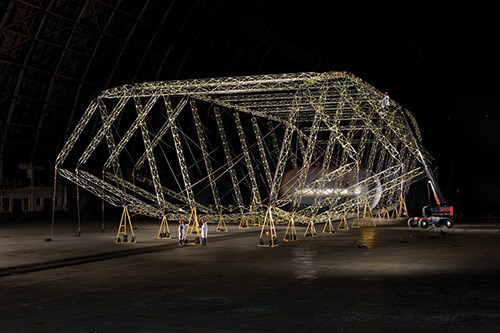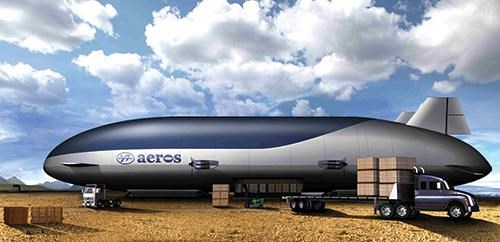Don’t call it a blimp!
The builders of this variable-buoyancy craft count on carbon fiber/epoxy trusswork to enable a new era of air transport.
Airships have been an important part of modern aviation since Count Ferdinand von Zeppelin envisioned the first such craft in 1874. Zeppelin’s design, which involved a rigid framework that supported the outer envelope or skin, meant that an airship could be made much larger and support more load than a simple gas-filled blimp.
Unfortunately, Zeppelin could not obtain helium (only available from sources outside Germany, it was embargoed because of Hitler’s armed buildup) and risked the use of flammable hydrogen. The Hindenburg tragedy in May 1937 and the onset of World War II ended Zeppelin’s successful and fashionable transatlantic flights, and heavier-than-air craft came to dominate the airways. Yet, the allure of airships lived on in the imagination.
Igor Pasternak, for one, imagines a new generation of airships with greatly expanded capabilities. He’s the founder, CEO and chief engineer at Worldwide Aeros Corp. (Aeros, Montbello, Calif.). Fascinated by lighter-than-air craft since childhood, Pasternak formed his first airship company in Ukraine, during the mid-1980s. After moving the company to the U.S. in 1994, he was able to secure funding through the development and sale of tethered military aerostats (lighter-than-air aerodynamic balloons) as well as conventional U.S. Federal Aviation Admin. (FAA)-certified airships. In 2005, he won a U.S. Defense Advanced Research Projects Agency (DARPA) contract to develop a strategic airlifter for possible military use.
The DARPA funds offered a chance to develop something radically new. Traditional blimps use helium-filled flexible envelope to provide lift, but need ground crews and tethers to stabilize the craft. Newer “hybrid” helium airships feature aerodynamic lifting surfaces and require a runway for takeoffs and landings. But when either type is used to carry cargo, the load has to be compensated for during offloading by ballast, typically sandbags or sometimes water, to combat the static lift of the gas. Ballast exchange management is difficult and is the reason that large airships have never been successful cargo carriers. Pasternak and his design team envisioned, instead, a rigid, variable-buoyancy airship, equipped with short side fins, vertical stabilizers and vertical takeoff and landing ability that requires no ballast. Although the DARPA military program ultimately ended, Aeros is endeavoring to build a fleet of what are now called Aeroscraft for commercial cargo roles. Its half-scale prototype, Dragon Dream, has successfully passed several tests and liftoff demonstrations.
Control of static heaviness
Aeros thinks big: Even the Dragon Dream prototype is 266 ft/82m long with a wingspan of 110 ft/34m, and more than 50 ft/15.4m tall. But two mammoth cargo craft have been designed: One 550 ft/169m long with a wingspan of 177 ft/54.5m and height of 120 ft/37m, will carry 132,000 lb (59.9 metric tonnes) of cargo, and a second, larger craft that will haul 500,000 lb (226.8 metric tonnes).
So what makes this concept, recognized by the U.S. Department of Defense and the U.S. Congress as worthy of further study, viable? That would be the central design element, Aeros’ patent-pending “control of static heaviness (COSH)” system. Similar to a submarine’s buoyancy system, says Tim Kenny, Aeros’ engineering department director, it features a pumping system that can capture the helium within the vessel’s envelope and compress it inside numerous holding tanks. When compressed, the gas becomes much heavier, and its containment creates a partial vacuum inside the airship envelope. Air is permitted to enter that void and inflate four large “expansion bladders” positioned along the vessel sides. The air inside the bladders plus the weight of the compressed helium causes a decrease in buoyancy, and the craft descends. When the helium is released back into the envelope, forcing the air bladders to empty, the airship ascends. Airship elevation is maintained and rate of ascent/descent is controlled via the helium’s tank vs. envelope balance. The system renders ground tethering crews and ballasting unnecessary, and opens the way for cargo transport to remote and unimproved locations.
Key to the concept’s success is the craft’s rigid internal structure, which must support not only the weight of the cargo, but the heavy COSH helium pump, compressors and storage tanks. Early trade studies showed that carbon/epoxy tubes in various diameters, assembled to form an airy truss skeleton (see photo, at left), could provide sufficient support at minimal weight. To shave cost during the demonstrator phase, some anodized aluminum tubing is used with the carbon, but Aeros intends to field future airships with all-carbon trusses.
“We ultimately determined that a truss design was the best way to handle bending loads, after multiple design iterations,” says Kenny. “We have divided the truss into sections, similar to a bridge design.” Carbon fiber/epoxy tubes in a range of diameters from 0.5 inch/12.5 mm up to 4 inches/100 mm, as well as some heftier square tube profiles, are assembled, together with the aluminum tubing, to form truss sections. The larger tubing is used, he explains, where loads are heavier, under the compressor equipment and engines, and where lifting or bending loads are anticipated to be the greatest. Sections are connected by complex tubular aluminum joints — the adhesive layer isolates the carbon and aluminum, preventing galvanic corrosion.
Aeros used Solidworks software from Dassault Systèmes (Waltham, Mass.) for the truss design, and conducted finite element analysis (FEA) of the entire structure under cargo-loading and bending conditions, using Nastran FEA software from NEi Software (Westminster, Calif.).
A new way to carry cargo
The majority of the composites comprise the truss structure, but other composite elements include the instrument panel, honeycomb-cored glass and carbon fiber cockpit floor panels and abrasion-resistant aramid fiber-reinforced composite fabrics on the craft’s ground-contact pads. Kenny reveals that in the full-scale airships, the outer skin might be made with more durable, rigid, lightweight composite panels, rather than the mylar film employed in the demonstrator.
The Dragon Dream successfully lifted off in 2013, says Aeros’ director of communications John Kiehle. Since then, Aeros has inked four memoranda of understanding with cargo transporters Pacific Airlift, Cargolux Airlines, Air Charter Service and Bertling Logistics, to explore shipping possibilities — Aeros intends to lease, not sell, the craft and will act as fleet operator. Target markets include oil and gas and wind energy (transport of blades and towers). The goal, says Kiehle, is FAA certification by 2016, and an active fleet soon thereafter.
Related Content
Prepreg compression molding supports higher-rate propeller manufacturing
To meet increasing UAV market demands, Mejzlik Propellers has added a higher-rate compression molding line to its custom CFRP propeller capabilities.
Read MoreLow-cost, efficient CFRP anisogrid lattice structures
CIRA uses patented parallel winding, dry fiber, silicone tooling and resin infusion to cut labor for lightweight, heavily loaded space applications.
Read MoreCutting 100 pounds, certification time for the X-59 nose cone
Swift Engineering used HyperX software to remove 100 pounds from 38-foot graphite/epoxy cored nose cone for X-59 supersonic aircraft.
Read MoreCarbon fiber, bionic design achieve peak performance in race-ready production vehicle
Porsche worked with Action Composites to design and manufacture an innovative carbon fiber safety cage option to lightweight one of its series race vehicles, built in a one-shot compression molding process.
Read MoreRead Next
Cutting 100 pounds, certification time for the X-59 nose cone
Swift Engineering used HyperX software to remove 100 pounds from 38-foot graphite/epoxy cored nose cone for X-59 supersonic aircraft.
Read MoreNext-gen fan blades: Hybrid twin RTM, printed sensors, laser shock disassembly
MORPHO project demonstrates blade with 20% faster RTM cure cycle, uses AI-based monitoring for improved maintenance/life cycle management and proves laser shock disassembly for recycling.
Read MoreCeramic matrix composites: Faster, cheaper, higher temperature
New players proliferate, increasing CMC materials and manufacturing capacity, novel processes and automation to meet demand for higher part volumes and performance.
Read More

































